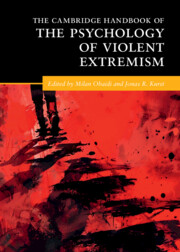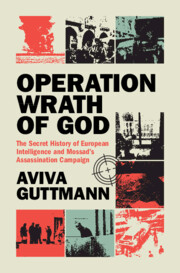Refine search
Actions for selected content:
692 results
18 - From Partners to Archenemies, 2000–2020
-
- Book:
- Distant Friends and Intimate Enemies
- Published online:
- 30 October 2025
- Print publication:
- 20 November 2025, pp 393-422
-
- Chapter
- Export citation
Terrorism and cultural heritage: an unconventional threat assessment
-
- Journal:
- International Journal of Cultural Property , First View
- Published online by Cambridge University Press:
- 13 November 2025, pp. 1-29
-
- Article
-
- You have access
- Open access
- HTML
- Export citation
Chapter 7 - The Political Messages of Samson Agonistes
-
- Book:
- Milton's Strenuous Liberty
- Published online:
- 23 October 2025
- Print publication:
- 06 November 2025, pp 179-205
-
- Chapter
- Export citation
Navigating dual roles: qualitative exploration of the psychological impacts on Muslim professionals supporting their community after a terror attack
-
- Journal:
- BJPsych Open / Volume 11 / Issue 6 / November 2025
- Published online by Cambridge University Press:
- 05 November 2025, e264
-
- Article
-
- You have access
- Open access
- HTML
- Export citation
Has mental health changed in children and adolescents registered with a dedicated support service responding to the Manchester Arena attack: 3-year follow-up: commentary, McFarlane
-
- Journal:
- The British Journal of Psychiatry , FirstView
- Published online by Cambridge University Press:
- 03 November 2025, pp. 1-2
-
- Article
- Export citation

The Cambridge Handbook of the Psychology of Violent Extremism
-
- Published online:
- 31 October 2025
- Print publication:
- 07 August 2025
8 - Terrorism
-
- Book:
- Human Rights Law in the UK
- Published online:
- 11 November 2025
- Print publication:
- 30 October 2025, pp 364-431
-
- Chapter
- Export citation
14 - Political Violence and Terrorism
- from Part II - The Traditional Security Agenda
-
- Book:
- Understanding International Security
- Published online:
- 11 October 2025
- Print publication:
- 30 October 2025, pp 280-300
-
- Chapter
- Export citation
Right-Wing Terror, Media Backlash, and Voting Preferences for the Far Right
-
- Journal:
- British Journal of Political Science / Volume 55 / 2025
- Published online by Cambridge University Press:
- 20 October 2025, e130
-
- Article
-
- You have access
- Open access
- HTML
- Export citation

Understanding International Security
- Theory and Practice
-
- Published online:
- 11 October 2025
- Print publication:
- 30 October 2025
-
- Textbook
- Export citation
4 - Gifts that Keep on Giving: Kashmir, Article 370, and Pakistan
-
- Book:
- Weaponizing Language
- Published online:
- 27 November 2025
- Print publication:
- 28 August 2025, pp 120-147
-
- Chapter
- Export citation

Operation Wrath of God
- The Secret History of European Intelligence and Mossad's Assassination Campaign
-
- Published online:
- 12 August 2025
- Print publication:
- 07 August 2025
3 - The Future of Violent Extremism Research
- from Part I - Concepts, Definitions, and Trends
-
-
- Book:
- The Cambridge Handbook of the Psychology of Violent Extremism
- Published online:
- 31 October 2025
- Print publication:
- 07 August 2025, pp 28-46
-
- Chapter
- Export citation
16 - The Role of Relative Deprivation in the Process of Radicalization into Violent Extremism
- from Part III - Group-Level Perspectives
-
-
- Book:
- The Cambridge Handbook of the Psychology of Violent Extremism
- Published online:
- 31 October 2025
- Print publication:
- 07 August 2025, pp 323-344
-
- Chapter
- Export citation
Introduction: Intelligence that Kills
-
- Book:
- Operation Wrath of God
- Published online:
- 12 August 2025
- Print publication:
- 07 August 2025, pp 1-14
-
- Chapter
- Export citation
17 - Navigating the Threat Landscape
- from Part III - Group-Level Perspectives
-
-
- Book:
- The Cambridge Handbook of the Psychology of Violent Extremism
- Published online:
- 31 October 2025
- Print publication:
- 07 August 2025, pp 345-365
-
- Chapter
- Export citation
20 - Foreign Military Interventions, Occupations, and Violent Extremism
- from Part IV - Macro-Level Perspectives
-
-
- Book:
- The Cambridge Handbook of the Psychology of Violent Extremism
- Published online:
- 31 October 2025
- Print publication:
- 07 August 2025, pp 410-425
-
- Chapter
- Export citation
18 - The Role of Dehumanization in Violent Extremism
- from Part III - Group-Level Perspectives
-
-
- Book:
- The Cambridge Handbook of the Psychology of Violent Extremism
- Published online:
- 31 October 2025
- Print publication:
- 07 August 2025, pp 366-386
-
- Chapter
- Export citation
4 - Individual Differences and Violent Extremism: Personality, Mental Disorders, and Risk Pathways
- from Part II - Individual-Level Perspectives
-
-
- Book:
- The Cambridge Handbook of the Psychology of Violent Extremism
- Published online:
- 31 October 2025
- Print publication:
- 07 August 2025, pp 49-77
-
- Chapter
- Export citation
22 - Climate and Catalyst Events and Their Intersection with Violent Extremism
- from Part IV - Macro-Level Perspectives
-
-
- Book:
- The Cambridge Handbook of the Psychology of Violent Extremism
- Published online:
- 31 October 2025
- Print publication:
- 07 August 2025, pp 451-473
-
- Chapter
- Export citation
